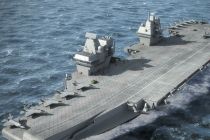HMS Queen Elizabeth aircraft carrier
Former name : HMS QE
HMS Queen Elizabeth aircraft carrier last position
The last location of HMS Queen Elizabeth aircraft carrier is in North East Atlantic Ocean cruising The AIS position was last reported 3 months ago.
Current PositionSpecifications of HMS Queen Elizabeth aircraft carrier
| Year of build | 2014 / Age: 53 |
| Flag state | United Kingdom |
| Builder | Babcock Marine Rosyth Dockyard (Rosyth, Fife-Scotland) |
| Class | CVF-QUEEN ELIZABETH-class aircraft supercarrier (unit R08) |
| Ferry route / homeports | HMNB Portsmouth (England UK) |
| Building cost | GBP 3,1 billion (EUR 3,72 billion / USD 5,25 billion) |
| Engines (power) | Rolls-Royce & Wartsila (112.6 MW / 150999 hp) |
| Propulsion power | 109 MW / 146171 hp |
| Speed | 25 kn / 46 km/h / 29 mph |
| Length (LOA) | 284 m / 932 ft |
| Beam (width) | 73 m / 240 ft |
| Gross Tonnage | 65600 gt |
| Passengers | 921 - 1171 |
| Crew | 679 |
| Beds | 1600 |
| Decks | 12 |
| Cabins | 470 |
| Decks with cabins | 2 |
| Sister-ships | HMS PRINCE OF WALES |
| Former names | HMS QE |
| Christened by | HM Queen Elizabeth II (The Queen of UK) |
| Owner | United Kingdom (Britain) |
| Operator | British Royal Navy |
HMS Queen Elizabeth aircraft carrier Review
Review of HMS Queen Elizabeth aircraft carrier
The 2014-built/2017-commissioned HMS Queen Elizabeth aircraft carrier is the first unit (ship pennant number/hull R08) of the UK’s new Queen Elizabeth-class aircraft supercarriers—Britain’s largest warships ever constructed. The sister ship HMS Prince of Wales (hull R09) was completed in 2017 and commissioned in 2019.
The combat vessel (IMO number 4907892) is UK-flagged (MMSI 235107775) and registered in Portsmouth, England. The military ship’s namesake is Cunard Line’s 2010-built MS Queen Elizabeth.
The UK’s new aircraft carriers project was initially titled “CV Future,” or simply “CVF” (Future Aircraft Carriers). The CVF project covered the design and construction of two units (the UK’s largest warships ever built for the Royal Navy). Eventually, the CVF project cost Britain GBP 6.2 billion (US$10.5B).
Each CVF ship has two large propellers that together can output ~80 MW (megawatts) of power—enough energy to run ~1,000 family cars, ~50 high-speed trains, or to power ~5,500 households.
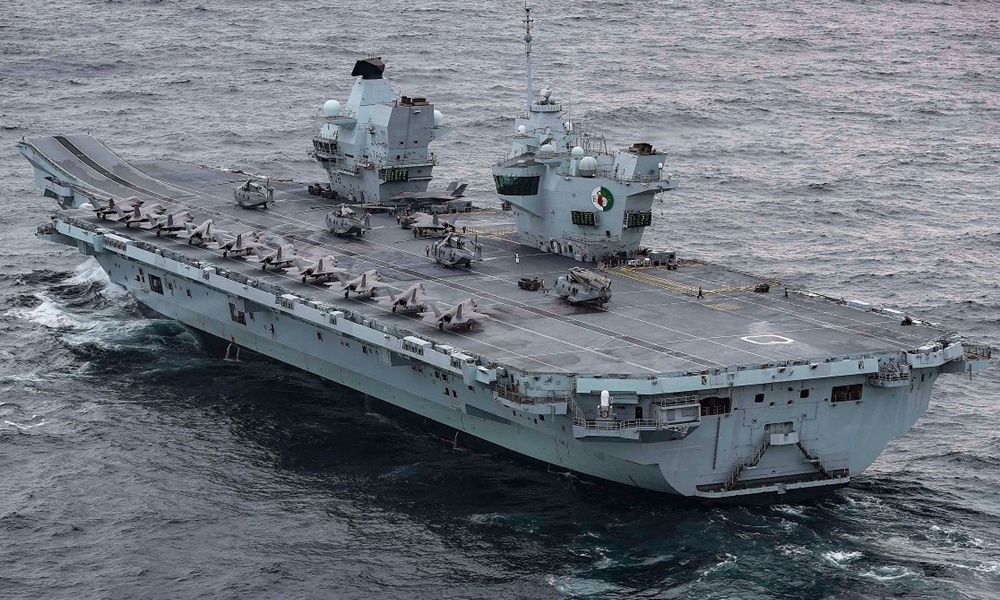
Each CVF ship has an overall height of 184 ft / 56 m (from keel to masthead, or 13 ft / 4 m taller than Niagara Falls), draft 36 ft / 11 m, overall width/flight deck beam 240 ft / 73 m (128 ft / 39 m waterline beam). There are nine decks beneath the flight deck, plus two “tower decks” above. The ship’s total deck space is ~170,000 ft² (~16,000 m²). The maximum range/endurance without refueling is 10,000 NM (11,500 mi / 19,000 km).
Service speed is 25 knots, while tested maximum speed is 32 knots (37 mph / 59 kph). The vessel’s expected lifespan/service life is 50 years (planned decommissioning in 2067).
Each of the two Queen Elizabeth-class warships can carry 40+ aircraft (surge capacity 65, theoretical maximum 72), with a maximum load of 36x F-35s (Lockheed Martin F-35 Lightning II) and 4x helicopters. The hangars are designed to store Boeing CH-47 Chinook (without blade folding) and Bell Boeing V-22 Osprey (tiltrotor) military helicopters.
The Queen Elizabeth aircraft carrier was assembled from nine large hull sections. Construction was carried out at six British shipyards—Rosyth (Fife/Scotland), Portsmouth (Hampshire/England), Glasgow (Govan/Scotland), Appledore (Devon/England), Newcastle (Tyne and Wear/England), and Birkenhead (Merseyside/England). The preassembled parts/mini-sections were transported on sea-going barges to Rosyth’s Babcock Marine yard (Drydock No. 1) to be welded together—a method similar to building the largest cruise liners.
At Rosyth (one of the cruise ports for Edinburgh), Babcock Marine yard’s Drydock 1 was specially extended to fit the CVF warships. The dock entrance was enlarged, and dredging was done at Portsmouth (their home base) to deepen and widen the existing channel.
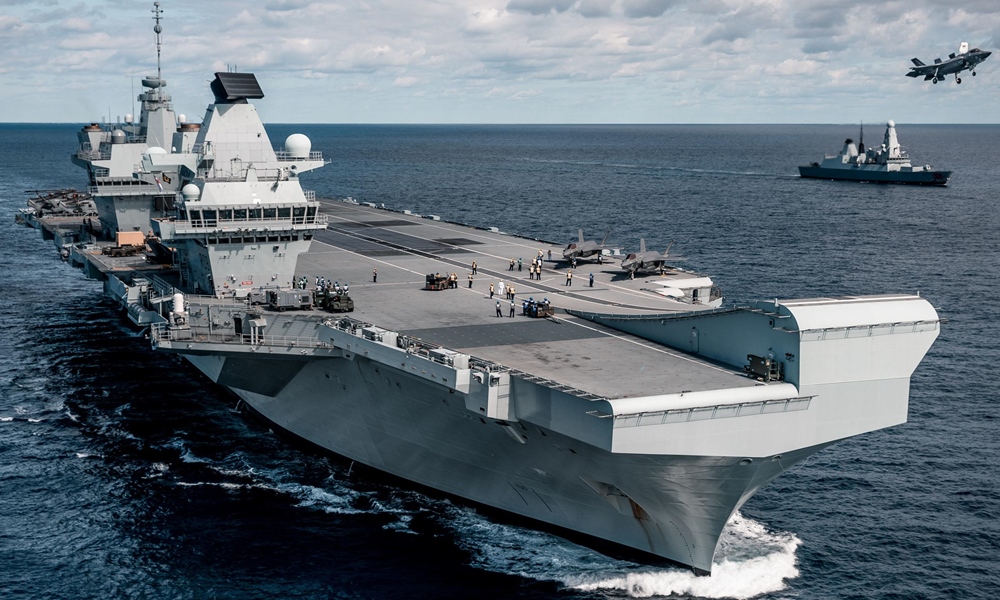
HMS Queen Elizabeth is the Royal Navy fleet’s flagship (Britain’s principal warship). The Navy’s previous operational aircraft carrier was HMS Ark Royal (hull number R07, Invincible-class, 1981-built/1985-commissioned/2011-decommissioned/2013-scrapped).
Vessel details, specifications, statistics
Builders: BAE Systems Surface Ships, Thales Group, Babcock Marine (see the ship’s WIKI section for more details).
Cost to Build: GBP 3.5 billion (USD 5.52 billion) for HMS Queen Elizabeth, which is exactly GBP 7B for both QE-class units by the 2008 contract. The funding was allocated (for both ships) as follows: GBP 1.325B to BVT Surface Fleet/BAE & VT Group joint venture (for hull sections at Govan and Portsmouth), GBP 300M to BAE (for sections at Barrow-in-Furness), GBP 675M to Babcock Marine (for the bow section/final assembly/completion at Rosyth), GBP 425M to Thales UK (design/engineering), GBP 275M to BAE (design and supply of Mission Systems/Insyte), plus additional contracts for steel, diesel generators, aircraft lifts, and key electronics.
Jobs created: hull section (Portsmouth – 1,200), hull sections (Govan/Clyde – 3,000+), hull section (Barrow-in-Furness – 400+), BAE Systems Insyte (Frimley, Surrey – 145), Thales UK (Bristol and Crawley – 250), assembly of both ships (Rosyth – 1,600). By the end of 2013, 10,000+ people were involved in building and equipping the UK’s newest warships.
Size Comparison: QEC/Queen Elizabeth-class warships are three times the size of HMS Indomitable/Ark Royal (the UK’s last Invincible-class carriers) and are second only to the USA’s nuclear-powered Nimitz-class carriers. Compared to Nimitz, QEC are manned by ~80% fewer crew, partly due to automation provided by a computerized IPMS (Integrated Platform Management System) with CORE software and a dedicated SIF (Shore Integration Facility) ashore that receives and processes in real time all transmitted ship data.
Food statistics: Meals are prepared by 40 chefs (among the kitchen staff) and served by 67 catering staff. Stores include 12,000 tins of beans, 64,800 eggs, 66,000 sausages, and 28,800 bacon rashers. The Bakery produces ~1,000 loaves of bread daily. The ship has six galleys/kitchens. The largest dining room (for Junior Ratings) has 960 seats.
HMS Queen Elizabeth’s first Captain was Commodore Jerry Kyd—former Captain of the UK aircraft carriers Ark Royal (1981–2013/scrapped) and Illustrious (1978–in active service).
Draft: 36 ft (11 m). Including the flight deck, the hull is nine decks deep. Due to budget restraints, a number of hull armor features were dropped from the original design (armored bulkheads and side armor plates). The hull design allows a future upgrade/conversion to accommodate a catapult launch system.
Volume/Displacement: 65,600 GT (64,600 long tons) at deep/full load—about three times the size of the Royal Navy’s three Invincible-class boats (Invincible/1973, Illustrious/1976, Indomitable/1978). A total of 80,000 tons of steel was used for both new warships.
Deck area/facilities: 172,220 ft² (16,000 m², described as “four acres of sovereign territory” at sea), a large hangar below deck (50,600 ft² / 4,700 m², volume 29,000 m³, max capacity 20 aircraft), flight deck (140,000 ft² / 13,000 m², with a ski jump/upward-curved ramp angled at 13 degrees), 2x aircraft lifts (70-ton capacity—two F-35s from hangar to flight deck in 60 sec), 2x engine rooms (forward and aft), Mission Control Center (war planning and coordination), various machinery rooms, water-treatment plant (daily freshwater production from seawater), ammunition stowage, aviation fuel tanks, ballast water tanks, freshwater tanks (capacity 500 tonnes), weapons handling bay, a gym (forward, under the mooring deck and adjacent to the anchors), a space for the crew to play football (in the passageways), accommodations for 1,650 (berths).
As the ship has no catapult system/arrestor wires, the ski-jump ramp aids jet take-offs, reducing fuel usage and improving mission range.
The brig/military prison has one police office and three cells and is managed by the Royal Navy Police Department (four service policemen).
The crew/permanent personnel is 1,600 and includes 679 (ship’s company) plus 921 (air wing). In addition, the ship can accommodate 250 Royal Marines/troops.
A special mobile app was developed for the crew to navigate the vessel’s 3,013 compartments. It was estimated the app would save ~GBP 1.2 million annually in wasted man-hours.
QE-class UK aircraft carrier armament (weapons, air arms)
Three Phalanx CIWS (automated Close-In Weapon Systems against anti-aircraft/anti-ship missiles), six barrels (caliber 20x102 mm), fire rate 4,500 rounds/min (75 rounds/sec).
Four 30 mm automated guns (DS30M Mark 2/small caliber, automated) plus six miniguns (for asymmetric threats).
The warship’s weapons monitoring and handling-deployment system HMWHS (“Highly Mechanised Weapon Handling System”) is about six times faster than on the previous (Invincible-class) British aircraft carriers. HMWHS is operated by only 50 people (minimum 12 personnel) and moves munitions on pallets via remotely controlled electric vehicles/lifts.
(maximum) 40 Aircraft
Lockheed Martin F-35 Lightning II (stealth capability)—a single-seat, single-engine, 5th-generation fighter for ground attack, reconnaissance, and air defense. Unit cost (in millions USD, 2012 data): F-35A (US$107M), F-35B (US$238M), F-35C (US$239M).
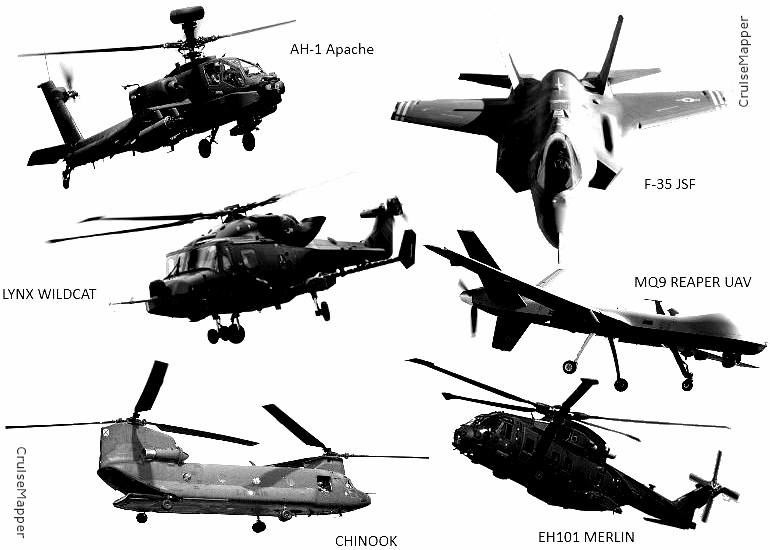
Boeing CH-47 Chinook (twin-engine, heavy-lift transport helicopter), average unit cost (US$35M), top speed (196 mph / 315 kph).
AgustaWestland AW101 Merlin (medium-lift helicopter, including Merlin Mk1 for anti-submarine warfare) and Boeing AH-64 Apache (attack helicopter), unit cost (US$21M for Merlin).
AgustaWestland AW159 Wildcat (aka Future Lynx, Lynx Wildcat)—a military helicopter (utility, search and rescue, anti-surface warfare), entered service with the British Army in 2014 and with the Royal Navy in 2015.
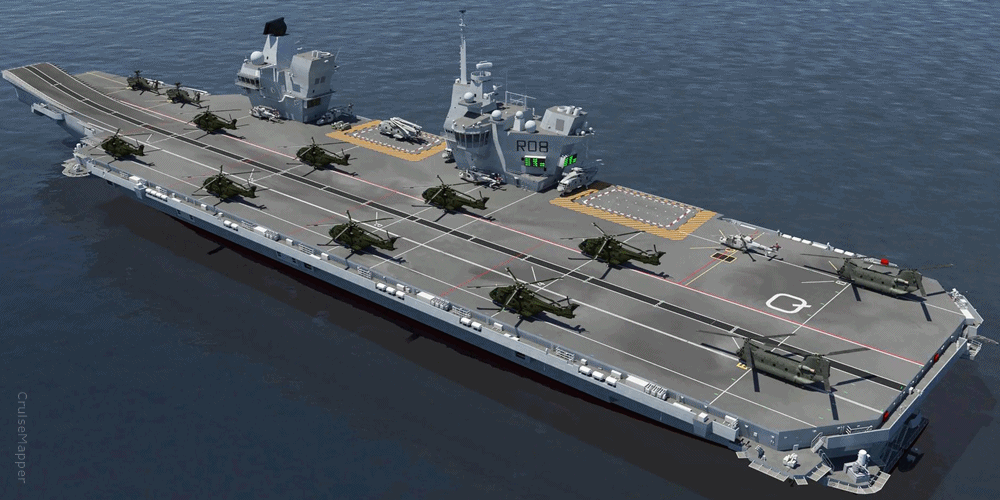
“Maritime Airborne Surveillance and Control” (MASC), formerly FOAEW (“Future Organic Airborne Early Warning System”), provides air and surface surveillance (detecting threat aircraft, missiles, sea-surface targets—Over-the-Horizon Targeting), as well as Tactical Control and Networking (to direct fighter intercepts, airspace management, air traffic control); speed 174 mph (280 kph), range 575 mi (925 km).

The ship has 4x PTBs/passenger transfer boats (by Alnmaritec), each with capacity for 38 people (36 passengers plus two operational crew). Each boat is 43 ft / 13 m long and davit-launched. The passenger boats are named Swordfish, Buccaneer, Sea Vixen, and Sea Harrier. There are also 24x RHIBs (rigid-hulled inflatable boats) plus inflatable liferafts (safety equipment).
QE-class UK aircraft carrier technology
The BAE Systems Insyte Artisan 3D radar is the most sophisticated in the RN fleet (~five times more efficient than any previous system in service), with a range between 656 ft / 200 m and 124 mi / 200 km. BAE’s Artisan radar is positioned on top of Aft Island, weighs ~700 kg, and can detect 800+ targets moving up to 1 km/s (~three times the speed of sound).
BAE’s long-range radar (model S1850M) is the same as on the Type 45 destroyers. It weighs 8+ tons (the antenna alone is ~700 kg) and is positioned above the Wheelhouse (on the Forward Island’s top). The radar can identify a tennis ball-sized target traveling at 2,000+ mph / 3,220 kph at a distance of 16+ mi / 26+ km. It can track 900+ targets simultaneously and operate in a densely signal-populated environment, cutting through interference equivalent to 10,000 GSM signals directed its way.
The Wheelhouse is equipped with the latest INBS (Integrated Navigation & Bridge System)—a multifunction console system incorporating electronic navigation systems and marine radar/satellite tracking.
The ship’s two propellers weigh 33 tons each (about 2.5 times heavier than a double-decker bus). Together they generate 80 MW of power—enough to run 50 high-speed trains. Two rudders are used for steering.
The ship has two anchors (fore-positioned, under the mooring deck portside/below the ski-jump), each 3.1 m (10.2 ft) high and weighing 13 tons. The anchor cables are of shackles. The portside chain is ~400 m (~1,300 ft) long and weighs ~90 tons. The starboard chain is shorter (343 m / 1,125 ft) and lighter (75 tons).
Flight deck is 919 ft (280 m) long and 243 ft (74 m) wide. It is coated with a metallic compound of aluminum and titanium (melted together and sprayed onto the surface). The special coating allows the open deck to withstand extreme temperatures up to 2,730°F / 1,500°C.
The vessel requires 1.5 million m² of paintwork (~16.5 million ft², or an area of ~370 acres / 150 hectares).
The ship’s main body is called “Super Block 03.”
The countries that currently have aircraft carriers include the USA, Russia, Brazil, India, France, Italy, Spain, China, and Thailand. The US Navy also has Ford-class supercarriers (10 planned units), which are nuclear-powered.
Compared to older designs, the new warship has two islands (on the flight deck) rather than one—forward (Navigation Bridge/Control Tower 1) and aft (air-traffic control/Flight Tower 2). Two heavy lifts (starboard) bring planes up from the hangar, whereas older carriers had lifts placed mid-flight deck. HMWHS (Weapon Handling System) selects and delivers ammunition from two large magazines to aircraft in the hangar, reducing crew requirements.
Bulbous bow—as on the largest cruise vessels, both new UK aircraft carriers feature a “bulbous nose,” a protruding bulb at the bow just below the waterline. It modifies water flow around the hull, reduces drag, and increases speed and operational range. The bulb also improves fuel efficiency (10–13%) and stability (increasing buoyancy at the forward hull and slightly reducing pitching). The “ER” on the bow stands for “Elizabeth Regina”—the warship’s coat of arms.
Decks and cabins
The aircraft carrier has a total of 470 cabins (prefabricated modular units) with 1,600 bunks. Of 302 crew cabins, 118 for Junior Ratings (six-berth cabins) are fitted with bunk beds and a foldaway sofa that provides eight berths if required (944 total for officers and sailors).
There are separate, larger staterooms for the ship’s Flag Officers and Commanding Officers, and two exclusive accommodations/suites—one for the Flag Officer (naval officer above captain/admiral, vice-admiral, rear admiral, commodore) and the other for the Commanding Officer/General (ultimate authority over the ship).
Common crew areas include conference/operation briefing rooms, office complex, restrooms (with toilets and showers), Junior Rates’ exclusive recreational facilities (Messhall, Fitness, Dining Hall, Galley), Senior Rates’ exclusive facilities (Wardroom, Dining Hall, Galley), Flag Officers’ and Commanding Officers’ exclusive facilities (Galley, Dining Room, Baggage Store), Bakery, Ward area, Shopping area (NAAFI’s naval canteen services—retail, hospitality, wholesale).
The Infirmary/Hospital complex groups all medical facilities and is staffed by 11 medical personnel (military physicians and nurses). The area houses an isolation ward, a 12-bed general-purpose ward, a dentist’s surgery, and an operating theatre.
Next is HMS Queen Elizabeth’s deck plan showing the position of all main facilities and machinery—deck 1 (flight deck), as well as decks 3, 5 & 8.
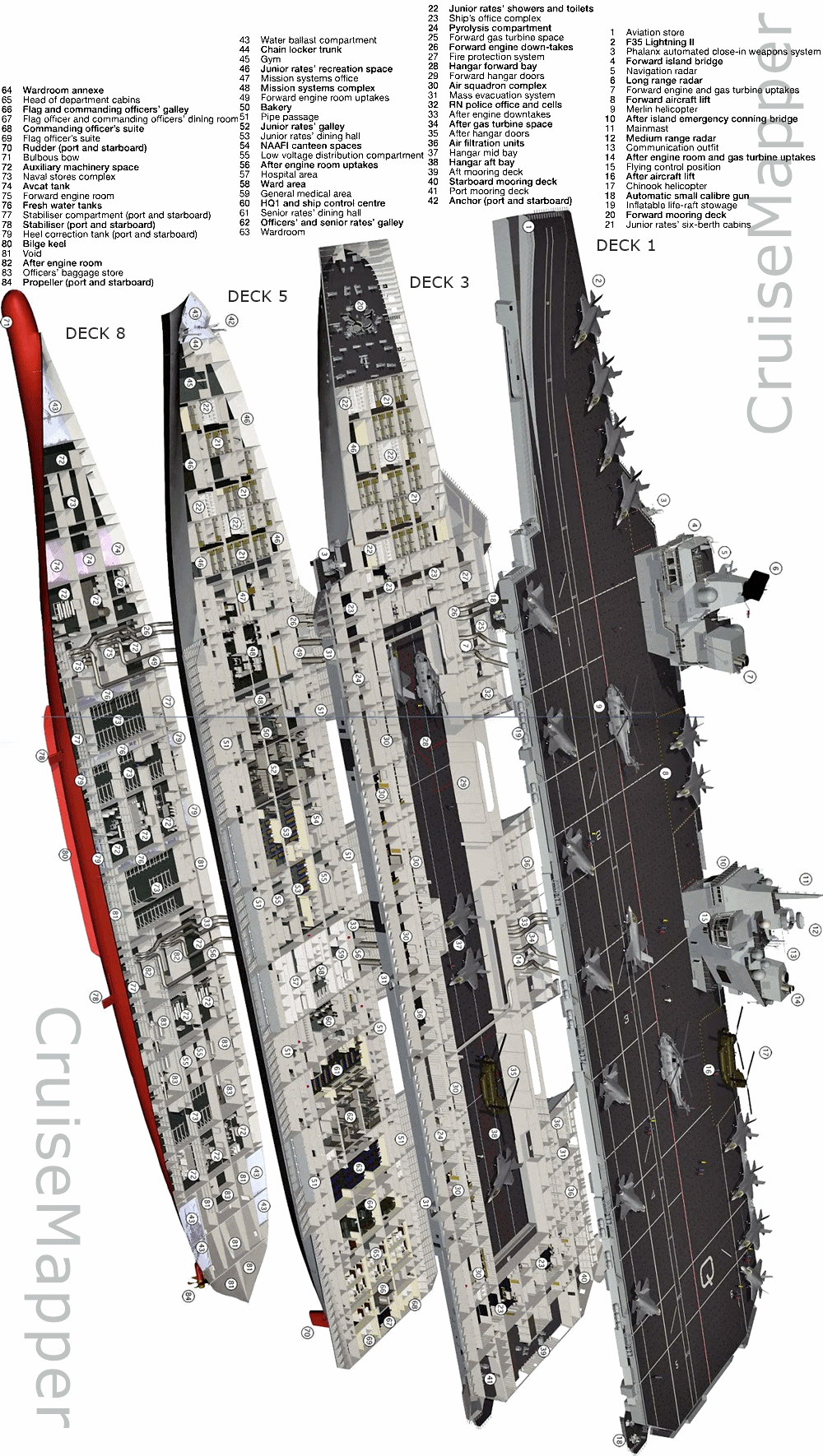
Even today, aircraft carriers remain the ultimate symbol of a nation’s naval power. In the words of Geoff Searle, program director for the ACA, warships such as HMS Queen Elizabeth “are a significant diplomatic tool—they can go anywhere and do anything”—a colossal mobile airfield you can park anywhere.
HMS Queen Elizabeth aircraft carrier ship related cruise news
- Cruise Industry
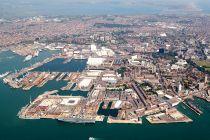
TUI's Mein Schiff 3 becomes the largest cruise ship ever to call at Portsmouth UK
The arrival of TUI's Mein Schiff 3, a massive cruise ship measuring 294 m / 964 ft in length, marks a significant moment for a coastal city. The...
May 26, 2023 - Cruise Industry
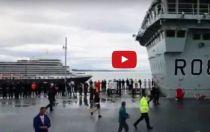
HMS Queen Elizabeth aircraft carrier meets Cunard's Queen Elizabeth
For the first time in history Cunard Line's Queen Elizabeth met HMS Queen Elizabeth (UK's largest aircraft carrier / link to queenelizabethcruises...
July 9, 2017 - show more news
Other Icebreakers cruise ships
HMS Queen Elizabeth aircraft carrier Wiki
HMS Queen Elizabeth was ordered on May 20, 2008, with the shipbuilding contract (for both units) signed in Portsmouth on July 3. The two-ship order was publicly announced on July 25, 2007, by Desmond Henry Browne (Baron Browne of Ladyton), the UK’s Secretary of State for Defence from 2006 to 2008.
Initially, the project’s budget was GBP 4.085 billion (~USD 8.4B / EUR 6B) for both units, with the first planned to enter service in July 2015. However, due to the 2008 financial crisis, construction slowed, the first ship’s delivery was postponed (to May 2016), and GBP 1.56B was added to the budget.
- By March 2010, the project’s total budget increased to GBP 5.9B.
- In November 2013, the two-ship building contract was renegotiated to GBP 6.2B (USD 10.5B).
- In May 2015, the UK’s MOD/Ministry of Defence paid ~GBP 3.12B for the program, including ~GBP 1.925B to BAE Systems and ~GBP 1.194B to Babcock International.
The project was supervised by Rear Admiral Henry Hardyman Parker (born 1963), MOD’s DE&S/Defence Equipment & Support Director of Ship Acquisition. In 2012-2013 he was the Controller of the Navy and in 2013 was appointed MOD’s Director (Carrier Strike).

HMS Queen Elizabeth’s construction officially started with the keel-laying ceremony on July 7, 2009. She was christened on July 4 and officially launched/floated out from drydock on July 17, 2014.
The QE warship’s motto is Semper Eadem (“Always the Same”)—a Latin phrase first used by Queen Anne Boleyn (1501-1536, Queen of England between 1533-36) and later by Queen Elizabeth I (1533-1603, Queen of England and Ireland between 1558-1603).
The first sea trials (handling and speed tests) were conducted in June 2017. The first aircraft landed on the ship on July 3. Her first bunkering stop was in Invergordon (for fueling and provisioning), where hull inspections were also carried out. Queen Elizabeth arrived at homeport HMNB Portsmouth on August 16, berthing at Princess Royal Jetty. The second sea trials were conducted October 30–November 21. The official commissioning was on December 7. The vessel was initially equipped with 14x F-35 jets and 120x British personnel.
All the largest sections were built in Portsmouth. Two of the main lower blocks (LB01 and LB02 / combined weight 6000 tons) were assembled on June 30, 2011. Lower Block 02 is 66 ft / 20 m high and 230 ft / 70 m long. Lower Block 03 (weight 8000 tons) was completed in Glasgow (Govan shipyard) and barged from Glasgow to Rosyth (a 600-mi / 970-km, 4-day voyage) on August 16–20, 2011. Block 04 (weight 11,000 tons) left Govan Shipyard on October 28, 2012, and arrived at Rosyth Dockyard on November 21.
Next YouTube video shows how the new UK aircraft carriers are being built (assembled, actually) by fitting blocks together to create both hull and superstructure. It also features absolute silence, which is likely intentional—to sharpen concentration ;)
HMS Queen Elizabeth construction milestones (2013)
The ship’s forward and aft islands were constructed at BAE Portsmouth and attached to the flight deck, respectively, in March and June 2013, while the flight deck’s ski jump was mounted in November.
On January 29, the first of two giant gas turbine engines was moved onto the ship.
On February 7, the forward island bridge tower (fully fitted out and painted, weight 680 tons) left Portsmouth on a barge bound for Rosyth (600-mi voyage). This section alone has 37 mi / 60 km of cables and 3101 pipes inside, and it took 16 months to build.
On April 15, Block SP08 aft was lifted and fitted at Rosyth.
On June 16, the aft island tower left BAE Scotstoun shipyard bound for Rosyth. On June 25, BAE Systems was contracted (GBP 5.5M) to deliver and install the VTMS (Vessel Traffic Management System).
On October 3, in Rosyth the flight deck was completed, with two giant sponsons (500 tons each) fixed into place.
On November 11, the ski ramp was completed. The ramp helps the F-35 jets get airborne/off the flight deck.
On November 28, the main radar (weight 8.4 tons) was added on top of the forward island tower.
On January 2, 2014, at Pax River, a Navy test pilot tested a kit to be used for moving the F-35B Lightning II stealth jets around the hangars. The new equipment (ESHA—“Electric Shipboard Handler”) was tested at Naval Air Station Patuxent River (~60 mi outside Washington DC USA). The new GBP 120 million stealth fighter replaced the Harrier jets and is three times heavier than the British aircraft. At the time, the UK owned 3x F-35Bs.
On January 23, 2014, US aircraft carrier senior personnel (US Navy and Marine Corps) visited HMS Queen Elizabeth at Rosyth, meeting representatives of ACA and touring the ship under construction. The list of Americans included VA Nora Tyson (aircraft carrier commander), VA David Buss (Naval Air Forces), LTG Robert Schmidle (Marine Corps Deputy, Aviation).
Next YouTube video shows the “ground view” perspective, with all the crane moves, of the new UK aircraft carriers’ construction process.
UK aircraft carriers builders
Both QE-class warships (Queen Elizabeth and Prince of Wales) were assembled at Rosyth Dockyard and built by the Aircraft Carrier Alliance—a 2003-founded joint venture between the UK’s Ministry of Defence and BAE Systems, Babcock International, and Thales Group. The Ministry of Defence acted as both member and customer.
For the CVF project the website AircraftCarrierAlliance.co.uk (now defunct) was created, where general information plus regular updates (on the vessels’ construction) and related news were published. Across the program’s supply chain, 700+ different businesses were involved.
Over 51 million man-hours were spent in the vessels’ design and construction, with ~17,000 people involved. Each warship is assembled from ~17 million parts. Pipes’ total length is 226 mi / 364 km. Electrical cables’ total length is 155,340 mi / 250,000 km. Optical cables’ total length is 4,970 mi / 8,000 km. Around 11,000 people worked at the construction sites, including ~3,000 at Rosyth Shipyard.
Most of the construction work was done at Rosyth Dockyard (owned by Babcock Marine Ltd), Govan Shipyard (owned by BAE Systems plc), plus four other yards—Hebburn Shipyard (A&P Tyne Ltd), Appledore Shipbuilders, Cammell Laird (founded 1828), and HMNB Portsmouth (Her Majesty’s Naval Base, one of the UK’s three operating Royal Navy bases—together with HMNB Clyde and HMNB Devonport).
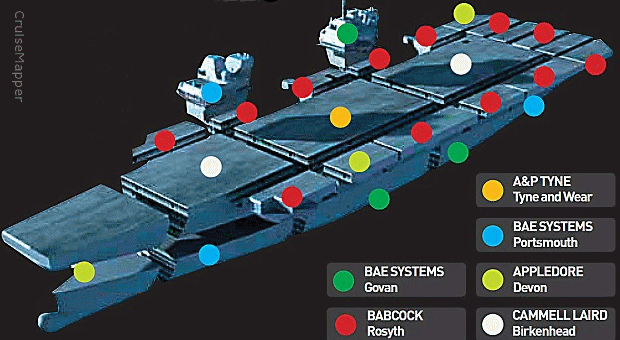
Babcock (BabcockInternational.com; construction sites Appledore and Rosyth) is a UK-based company with four main divisions—three for UK operations (Marine and Technology, Defence and Security, Support Services) and one International (for the Middle East/Africa). Babcock’s Marine division is the major support partner to the Royal Navy (with over 75% share in the annual maintenance/refit of the RN’s surface ships).
BAE Systems (BaeSystems.com; construction sites Glasgow, Portsmouth, Cammell Laird, Birkenhead) is a global corporation and provider of defense and security products (cyber services, military support, mission-critical electronic systems, protection equipment, and more), with well over 100,000 employees worldwide (the majority in the USA and UK). Reported sales of GBP 22.4B (US$36.2B).
Thales Group UK (ThalesGroup.com) is a global company specializing in the technology markets for Aerospace, Space, Defence, Security, and Ground Transportation. Thales Group has 67,000+ employees (in 56 countries) and global revenue ~GBP 11.5 billion.
Britain’s Ministry of Defence (gov.uk/government/organizations/ministry-of-defence) is a ministerial department, supported by 30 agencies/public bodies, working on defense/armed forces, national security, and foreign affairs.
A&P Group (ap-group.co.uk; construction site Hebburn) is the UK’s largest ship repair/conversion company, with three huge shipyards (Hebburn, Middlesbrough, Falmouth).
Engines, power, propulsion
The vessel’s powerplant includes CODLAG (combined diesel-electric and gas turbine propulsion), two 36 MW Rolls-Royce turbines, two “Wartsila 16V38” diesels (16-cylinder, with 11.6 MW generators), two “Wartsila 12V38” diesels (12-cylinder, with 8.7 MW generators)—both models with turbochargers—one “Wartsila 12V200” (2 MW emergency diesel generator set), two propeller shafts (each with 2x Alstom 15-phase electric motors at 150 rpm; total power 80 MW; output 95,000 shp).
The ship’s main diesel-generator sets (Wartsila 38) supply 40 MW of the total 112.6 MW, with the remainder generated by the two gas turbines. The ship is also fitted with a Wartsila MBR200N (Membrane BioReactor), an advanced wastewater (grey- and black-water) processing system based on biological degradation and membrane separation. Wartsila MBR200N produces high-quality discharge without adding or generating hazardous chemicals.
Rolls-Royce Marine gas turbines
Both QE-class UK aircraft carriers have the most powerful marine gas turbines in the world. HMS Queen Elizabeth’s power output is 109 MW (total, without the emergency and auxiliary engines). This impressive power generation capability is based on two 120-ton Rolls-Royce MT30 gas turbines.
Each of the ship’s two MT30 gas turbines (first produced in 2002) generates 36 MW—enough to power a small town. Both turbines provide power for the two propellers, weapons, sensors, command systems, and the ship’s low-voltage requirements. The MT30 turbine was engineered to meet the needs of both naval ships and commercial marine vessels. Its naval applications include frigates, destroyers, and aircraft carriers. Key features include:
- compact size (15 ft / 4.5 m in length)
- lightweight (total module weight as a set is 77 tons)
- great flexibility in ship design, ideal for newbuilds and fast-turnaround maintenance programs
- full authority digital control
- fully integrated alarm, monitoring, and control, with its own integral fire protection system
In 2012, Rolls-Royce Marine repackaged the MT30 turbine so it would fit into smaller ships. The company offered the MT30 to the Royal Navy for the CODLOG system in the Type 26 frigates (construction started in 2015). The MT30 design is based on the Rolls-Royce Trent 800 aero engine, which achieved a 44% share of Boeing’s 777 programs.
Wartsila 38 diesel engines
Both QE-class aircraft carriers’ propulsion systems feature Wartsila 38 marine diesel engines as prime movers. This high-technology, revolutionary design (engine and surrounding powerplant) aims to achieve the lowest possible kilowatt-hour/kWh production cost.
Wartsila 38 engine’s best features, in comparison to other models, and general specifications are:
- fewer parts (less maintenance)
- lower fuel consumption; multi-fuel (reliably runs on various fuels)
- reduced greenhouse gas emissions; full compliance with IMO Tier II (new regulations regarding exhaust emissions level—see NOx/Nitrogen Oxides Regulation 13 at IMO.org)
- durable, reliable, cost-efficient
On both aircraft carriers (R08 and R09) a modified 14-cylinder version with inline cylinders was installed.
- cylinder bore 38 cm (15 in)
- piston stroke 47.5 cm (18.7 in)
- cylinder displacement 1,820 liters (each cylinder); total engine displacement for the 14-cylinder version up to 25,480 liters
- power output per cylinder 725 kW
The Finnish company Wartsila also lists the world’s most powerful diesel engine—the “Wartsila-Sulzer RTA96-C.” This turbocharged 2-stroke engine is designed to provide propulsion for the world’s largest container ships and supertankers.
Rolls-Royce propulsion system
Both new UK aircraft carriers have an IFEP propulsion system (“Integrated Full Electric Propulsion”) consisting of 4x 20 MW (27,000 hp) AIM electric motors (“Advanced Induction Motor”) by Converteam UK. These motors are similar to those on the Type 45 Royal Navy destroyers (the destroyers use two motors, one per shaft). The AIM motors are driven by a Converteam VDM 25000 modulated converter able to produce various frequencies, allowing control of shaft speed across the operating range and eliminating the gearbox in the propulsion system.
The two Wartsila 16V38 engines power the Converteam generators (positioned low in the ship for stability), while the two MT30 turbines are installed higher in the structure (shortening air/exhausts down/up-takes).
The four propulsion motors (per aircraft carrier, two per shaft) are positioned in three separate compartments for better survivability and damage control. The US company L-3 Communications Holdings supplied the command-and-control propulsion power system (controlling the turbo and diesel generator sets).
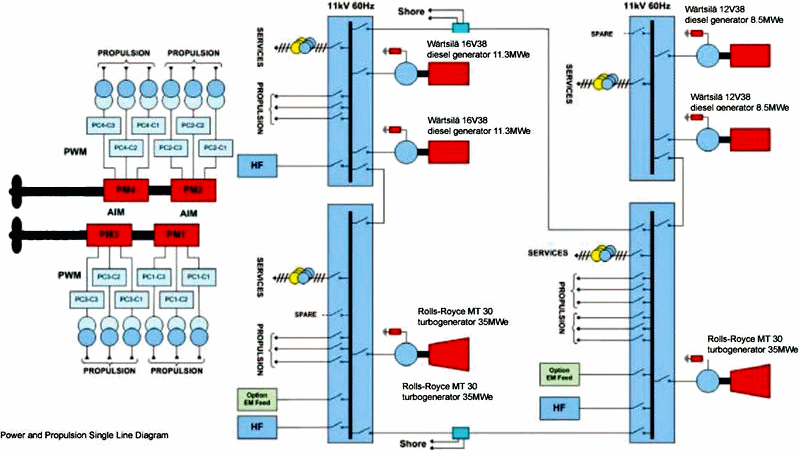
Rolls-Royce produced and delivered the CPPs (5-blade controllable-pitch propellers), which are bolted and adjustable to allow more efficient blade matching and simpler installation. The five blades are nickel-aluminum bronze and bolted from the inside. The hollow hub’s slotted holes allow pitch angles to be adjusted depending on hull design/water resistance. The units’ weight was specifically reduced (for easier handling and mounting), and blades can be replaced (if damaged) without drydocking. Each propeller has a diameter of 7 m (23 ft) and weighs 33 tons.
The steering gear (2x per ship) is also by Rolls-Royce Marine. The rotary vane steering system integrates two actuators (with lubricated rudder carrier bearings), hydraulic power units, and control and alarm systems. Rotary vane steering gears allow full torque at all rudder angles, giving more flexibility: Rolls-Royce’s RV2600-3 vane units have max torque of 1,845 kNm (kilonewton-meter) per unit. The ship’s two rudders (by Rolls-Royce) are independent and have twisted blades to minimize cavitation.
The ship has two shaft lines (total weight ~240 tons) fitted with rope guards, water-lubricated bearings, plummer and thrust bearings, and STL/Stop-Turn-Lock equipment.
The ship’s four stabilizers with retractable fins (folding into slots in the hull) are of the Neptune type (also used for large passenger vessels/cruise ships and ferries). The fins (total area 11.5 m²) are mounted as pairs (2x forward + 2x aft). At 18 knots (21 mph / 33 kph) their roll reduction is ~80%.
Rolls-Royce electrical system
Rolls-Royce also designed, manufactured, delivered, and installed the ship’s LV electrical power distribution equipment and control system, including 13x switchboards (each with capacity over 4000 A), 1x emergency switchboard, 34x distribution centers, 400x distribution panels, 27x starter boards (that control the low-voltage motors), 50x motor starters (that control the motors’ electrical machines), 31x changeover switches, 104x auxiliary transformers, and 10x UPS units (uninterruptible power supply/energy storage for all critical-mission and safety systems).
The company also supplied the Medical Power System (for the Infirmary’s medical facilities) and 2x DG Panel Boards (diesel-gensets).
Ship christening (2014)
The QE aircraft carrier’s naming ceremony was held on Friday (July 4, 2014) and led by godmother Her Majesty Elizabeth II (Queen of the UK and Britain’s 14 Commonwealths). The event featured a prime Scotch whisky bottle smashed into the hull (instead of the traditional champagne), as well as aerial acrobatics by Lockheed Martin F-35 Lightning II aircraft—making its first flight outside the USA to honor the event.
After the July 4 naming ceremony, the F-35B Lightning II was also scheduled to perform aerial acrobatics at the Royal International Air Tattoo (RIAT, the world’s largest military airshow, held at RAF Fairford / Gloucestershire, England) and at the Farnborough International Airshow (Farnborough Airport / Hampshire, England).
The naming was in Scotland (held at Rosyth Dockyard). The Scottish Bowmore Distillery (on Islay Island) was the first-ever distillery officially visited by HM The Queen (1926-2022).
The ship naming ceremony was attended by Prince Philip, Duke of Edinburgh (1921-2021 / Lord High Admiral at the time), Admiral Sir George Michael Zambellas (First Sea Lord at the time), British politicians David Cameron (Prime Minister/2010-2016) and James Gordon Brown (Prime Minister/2007-2010), Alexander Elliot Anderson Salmond (Scotland’s First Minister/2007-2014), as well as American and French senior naval officers.




